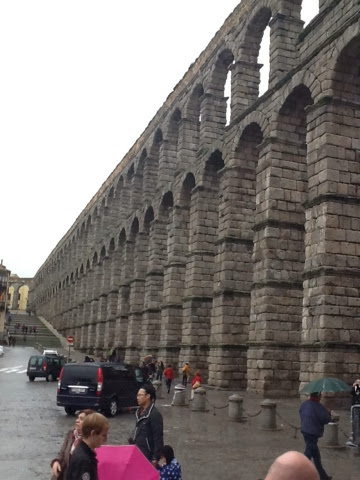Olé!
Flamenco dancing is one of the most impressive live performances I have ever experienced. I absolutely love "ethnic" and "world" music because the different cultural styles often overlap. This crossover between countries is really interesting to hear, and even more interesting to see live.
WARNING: I am a percussionist, so the following might seem really nerdy. I apologize. #sorrynotsorry
First off, the food at the Flamenco venue was absolutely delicious! The time of the meal was also very authentic to Spanish culture because the seniors and a few "significant others" arrived at the venue around 10:00pm. The Spanish #turnup rather late.
After the meal, the eight performers crowded the stage. Four members were part of the band, two guitarists and two vocalists, and the remaining four danced. The three female dancers each dawned a different dress, varying in style and color. Each woman represented a different cluster of emotions such as passion, desire, envy, and indignantcy revolving around the male dancer. The emotions were so dramatically conveyed that the audience was able to feel the injustices, the pain, and the joy with the dancers.
The band and the dancers acted as one throughout the performance, but the band reminded of a jazz rhythm section. The two vocalists would sing and usually begin the bass rhythms of the dance and the guitarists would layer chords and expand on the bass rhythms. Then, throughout the dance they would comp and feed off of the dancer, which is identical to the way a rhythm section interacts with a soloist. I loved seeing this overlap.
The vocalist weren't the only clappers. Infact, all of the dancers, whether participating in the dance or not, expanded in the rhythmic clapping. One of the many interesting things about Flamenco is the many different paths that percussive rhythms can take, but certain styles do offer restrictions. For instance, many people are familiar with the Tango, a strong 4/4 pattern that emphasizes beats one and three. This was NOT the style of Flamenco we experienced. The umbrella term for the type of Flamenco we experienced is Fandango de Huelva which has a very free twelve beat rhythm that usually emphasizes beats 3, 6, 8,10, and 12. This rhythm is the accompanied by other groupings of 3 and 6. The complexities of the many different types of styles, rhythmic voicings, and improv components amazed me and I can not even imagine thinking off all these complexities while dancing. It's true art.
I honestly can't even begin to describe the feet of the dancers. Their feet would often copy the rhythms of the claps, but put it in double time. You should really look up Flamenco dancing on YouTube to understand how fast their feet move.
It was truly and unbelievable experience to hear the rhythmic styles I had learned performed into such an artistic sense. Your hands and feet are the simplest instruments, but their raw qualities highlight the impressiveness of the style and culture surrounding Flamenco.





















